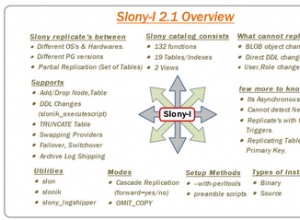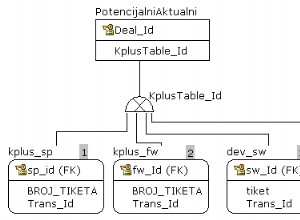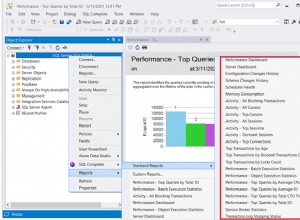Sí; usando el LEAD() función analítica, puede calcular el próximo effdt en las tablas de trabajos y beneficios, lo que facilita la consulta entre los rangos.
Algo como:
with dates as (select trunc(sysdate, 'yyyy') - 1 + level the_date,
to_number(to_char(trunc(sysdate, 'yyyy') - 1 + level, 'mm')) monthofyear,
to_number(to_char(sysdate, 'yyyy')) calendar_year
from dual
connect by level <= 365),
jobs as (select 123 emplid, to_date('01/02/2015', 'dd/mm/yyyy') effdt, 900 deptid, 'A' hr_status from dual union all
select 123 emplid, to_date('30/06/2015', 'dd/mm/yyyy') effdt, 900 deptid, 'I' hr_status from dual union all
select 123 emplid, to_date('01/08/2015', 'dd/mm/yyyy') effdt, 901 deptid, 'A' hr_status from dual),
benefits as (select 123 emplid, to_date('01/03/2015', 'dd/mm/yyyy') effdt, 'PPO' benefit_plan, 'A' status from dual union all
select 123 emplid, to_date('31/07/2015', 'dd/mm/yyyy') effdt, null benefit_plan, 'I' status from dual union all
select 123 emplid, to_date('01/09/2015', 'dd/mm/yyyy') effdt, 'HMO' benefit_plan, 'A' status from dual),
-- ********* end of mimicking your tables ********* --
j as (select emplid,
effdt,
deptid,
hr_status,
lead(effdt, 1, sysdate) over (partition by emplid order by effdt) next_effdt
from jobs),
b as (select emplid,
effdt,
benefit_plan,
status,
lead(effdt, 1, sysdate) over (partition by emplid order by effdt) next_effdt
from benefits)
select distinct j.emplid,
d.calendar_year,
d.monthofyear,
j.deptid,
b.benefit_plan
from j
inner join dates d on (d.the_date >= j.effdt and d.the_date < j.next_effdt)
inner join b on (j.emplid = b.emplid)
where d.the_date <= sysdate
and d.the_date between to_date (:year_prompt || '01-01', 'YYYY-MM-DD')
and to_date (:year_prompt || '12-31', 'YYYY-MM-DD') -- if no index on d.the_date, maybe use trunc(the_date, 'yyyy') = :year_prompt
and b.status = 'A'
and d.the_date between b.effdt and b.next_effdt
order by 1, 4, 2, 3;
EMPLID CALENDAR_YEAR MONTHOFYEAR DEPTID BENEFIT_PLAN
---------- ------------- ----------- ---------- ------------
123 2015 3 900 PPO
123 2015 4 900 PPO
123 2015 5 900 PPO
123 2015 6 900 PPO
123 2015 7 900 PPO
123 2015 9 901 HMO
123 2015 10 901 HMO
123 2015 11 901 HMO
(Obviamente, puede excluir las dates , jobs y benefits subconsultas de la consulta anterior, ya que ya tiene esas tablas. Solo están presentes en la consulta para simular tener tablas con esos datos sin necesidad de crear las tablas).
ETA:aquí hay una versión que solo calcula los 12 meses en función del año pasado, lo que reduce las filas de fecha a 12, en lugar de 365/366 filas.
Desafortunadamente, aún necesitará el distintivo, para tener en cuenta cuando tiene varias filas que comienzan en el mismo mes.
Por ejemplo, con los datos del siguiente ejemplo, terminaría con 3 filas para el mes 6 si eliminara el distintivo. Sin embargo, el número de filas en las que operará el distintivo será mucho menor que antes.
with dates as (select add_months(to_date(:year_prompt || '-01-01', 'YYYY-MM-DD'), - 1 + level) the_date,
level monthofyear,
:year_prompt calendar_year -- assuming this is a number
from dual
connect by level <= 12),
jobs as (select 123 emplid, to_date('01/02/2015', 'dd/mm/yyyy') effdt, 900 deptid, 'A' hr_status from dual union all
select 123 emplid, to_date('15/06/2015', 'dd/mm/yyyy') effdt, 900 deptid, 'I' hr_status from dual union all
select 123 emplid, to_date('26/06/2015', 'dd/mm/yyyy') effdt, 900 deptid, 'A' hr_status from dual union all
select 123 emplid, to_date('01/08/2015', 'dd/mm/yyyy') effdt, 901 deptid, 'A' hr_status from dual),
benefits as (select 123 emplid, to_date('01/03/2015', 'dd/mm/yyyy') effdt, 'PPO' benefit_plan, 'A' status from dual union all
select 123 emplid, to_date('31/07/2015', 'dd/mm/yyyy') effdt, null benefit_plan, 'I' status from dual union all
select 123 emplid, to_date('01/09/2015', 'dd/mm/yyyy') effdt, 'HMO' benefit_plan, 'A' status from dual),
-- ********* end of mimicking your tables ********* --
j as (select emplid,
trunc(effdt, 'mm') effdt,
deptid,
hr_status,
trunc(coalesce(lead(effdt) over (partition by emplid order by effdt) -1, sysdate), 'mm') end_effdt
-- subtracting 1 from the lead(effdt) since here since the original sql had d.the_date < j.next_effdt and we need
-- to take into account when the next_effdt is the first of the month; we want the previous month to be displayed
from jobs),
b as (select emplid,
trunc(effdt, 'mm') effdt,
benefit_plan,
status,
trunc(lead(effdt, 1, sysdate) over (partition by emplid order by effdt), 'mm') end_effdt
from benefits)
select distinct j.emplid,
d.calendar_year,
d.monthofyear,
j.deptid,
b.benefit_plan
from j
inner join dates d on (d.the_date between j.effdt and j.end_effdt)
inner join b on (j.emplid = b.emplid)
where d.the_date <= sysdate
and b.status = 'A'
and d.the_date between b.effdt and b.end_effdt
order by 1, 4, 2, 3;
EMPLID CALENDAR_YEAR MONTHOFYEAR DEPTID BENEFIT_PLAN
---------- ------------- ----------- ---------- --------------------------------
123 2015 3 900 PPO
123 2015 4 900 PPO
123 2015 5 900 PPO
123 2015 6 900 PPO
123 2015 6 900 PPO
123 2015 7 900 PPO
123 2015 9 901 HMO
123 2015 10 901 HMO
123 2015 11 901 HMO




